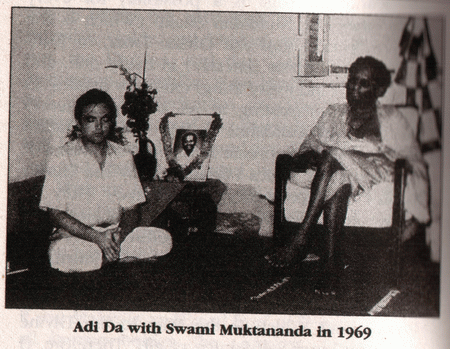
Letter from Swami Muktananda to
Franklin Jones
August 15, 1969
This letter giving Franklin the
name Dhyanananda appears in the first edition of The Knee of
Listening. This translation was presented to Franklin by
Muktananda’s secretary, Amma (Swami Prajananda).

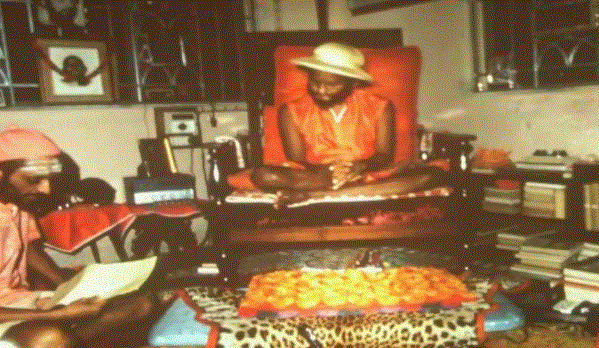

You have sought and found peace
in meditation. You have evinced keen interest in meditation.
Since meditation has become the aim of your life, you are
being hereby named as DHYANANANDA. You will hereafter be
known as DHYANANANDA in the field of Yoga.
You are a promising student of
Shree Gurudev Ashram. Chiti Shakti, the Kundalini, which
brings about Siddha Yoga, is activated in you. You have also
studied Vedanta. The Inner Self which is the secret of
Vedanta, the basis of religion, the realization of which is
the ultimate object of human life, is awakened in
you.
Only he who has himself seen can
show unto others. On the same principle you can now initiate
others into meditation.
The scriptures declare that so
long as you have unflinching faith in the Guru, so long as
you remain immersed in the thought of God, so long as you
have equal reverence for everyone, Kundalini, the divine
power, will continue to help you fully in achieving your
rightful share in material and spiritual
wealth.
The Kundalini Yoga can be
imparted to anyone since the Kundalini power exists in
everyone and everything exists in Kundalini.
May you be blessed with the
ultimate experience of oneness with God through the
performance of your duty and through his worship in the form
of meditation.
(SWAMI MUKTANANDA)
The Translation of Swami
Muktananda’s Letter
Swami Muktananda’s Naming letter,
because it is a unique acknowledgement by a great Spiritual
Realizer of Bhagavan Adi Da’s Spiritual Realization and
qualification to Teach, has been the subject of a great deal
of careful “consideration” on His part over the years,
especially with regard to its full and exact meaning. Thus
the detailed story of how the letter was given and the
various translations that have been made is an important
one.
Although the letter was only a page
in length, it was not until nearly two weeks after Swami
Muktananda wrote the letter that the document and its
translation were finally presented to Bhagavan Adi Da. It
appeared that the principal reason for the delay was that
the individuals entrusted with its translation would have
preferred that the letter not be given to Him at all, or, if
it were, that its obvious significance as Swami Muktananda’s
acknowledgement of a Western devotee’s Spiritual attainments
be minimized. Thus, the process of translation had been
colored by the emotions of those making the translation. In
addition, despite the resort to a professor of English, the
language of the translation was far from fluent. Thus, what
Bhagavan Adi Da received in 1969 was altogether a rather
awkward and uncommunicative translation of the Swami’s
words.
Because of the poor quality of the
translation and the circumstances surrounding its making,
Bhagavan Adi Da’s own devotees sought in later years to
clarify Swami Muktananda’s actual intention and meaning in
the letter by obtaining a precise and full translation from
an independent source. Thus, in the late 1970s, several
scholarly translations were commissioned. Although the new
translations were in some respects better than the original
translation of 1969, they betrayed the limitations of the
merely academic and scholarly approach. The translators
clearly did not understand Swami Muktananda’s Spiritual
purpose and point of view, and, therefore, their
translations did not adequately represent Swami Muktananda’s
intended meaning in the letter.
Finally, in 1984, an Indologist and
scholar of various Hindu Adepts, with a sensitivity to
Spiritual terminologies, meanings, and issues, brought to
light elements of the letter that had never been translated.
The language of the 1984 translation was more sophisticated
than earlier versions. Its flowing ease seemed more fitting
to Swami Muktananda than the halting style of the original
translation, for although Swami Muktananda was not a highly
educated man, his language carried a forcefulness and power
that had not appeared in earlier translations.
Most revealing, however, was the
1984 translator’s discovery of specifc language, in the
original text of the letter, indicating Swami Muktananda’s
evaluation of Bhagavan Adi Da’s Spiritual development.
According to this new version, Swami Muktananda forthrightly
proclaims his disciple’s Realization by stating that
Dhyanananda was Yogically Self-Realized, having “fulfilled
the sadhana of dhyana”, having become “realized in dhyana”,
and having “realized the mystical tradition of Vedanta”.
This new translation appeared to rescue the lost essence of
the letter from the original translators’ apparent efforts
to obscure the Swami’s gift of acknowledgement to Bhagavan
Adi Da.
Having presumed that a final
translation had at last been achieved, Bhagavan Adi Da
proceeded in 1986 to write the first version of
“The
Order of My Free Names“,
which was published later that year. There the matter would
surely have come to rest, had not Bhagavan Adi Da Himself,
soon after that publication, raised new questions about
several words in the 1984 translation. At His request, the
original letter and the 1984 translation were submitted to
further scrutiny by new translators.
Bhagavan Adi Da had noted that Swami
Muktananda’s handwriting becomes both more informal and more
difficult to read in the second half of the letter. The new
translators discovered that several words in this section of
the letter had indeed been misread, and thus mistranslated,
by all previous translators. This led them to conclude that
the 1984 translator had overstated Swami Muktananda’s
language regarding the fullness and extent of Bhagavan Adi
Da’s Yogic Realization.
This criticism of the 1984
translation is more naturally in accord with Swami
Muktananda’s own position regarding the nature of Yogic
Realization and his likely understanding of his young
devotee’s experience at that time. Swami Muktananda regarded
the stable visualization of the “blue pearl” to be the
primary evidence of supreme Realization.1
However, at the time Swami
Muktananda’s letter was written (soon after Adi Da’s arrival
for His second visit to the Swami), Adi Da had not yet
experienced the myriad Spiritual phenomena (including
visualization of the “blue pearl”) that came to characterize
this visit. Thus, at the time Swami Muktananda wrote the
letter, the only report of meditative experience that he had
received from Bhagavan Adi Da was the letter Adi Da had
written in 1968 (after His retum to the United States)
describing His experience of fifth stage conditional
Nirvikalpa Samadhi toward the end of His first visit to
Swami Muktananda. Given Swami Muktananda’s valuing of
savikalpa samadhi above fifth stage conditional Nirvikalpa
Samadhi, Swami Muktananda would not have interpreted
Bhagavan Adi Da’s Realization of the latter (or His
experience of the internal revelation of the meditative
process on the morning of the letter writing) as the supreme
Yogic Realization.
Therefore, in 1989, with Swami
Muktananda’s letter scheduled for republication as part of a
revised form of “The
Order of My Free Names“, a
definitive translation was again sought. After all this
time, the problems of translation had not finally been fully
solved.
Although Swami Muktananda’s letter
was written primarily in Hindi, it was interspersed with
Sanskrit Spiritual terms. Further, there are a number of
places in the letter where he does not follow traditional
grammatical rules. Therefore, a definitive translation would
require someone who was familiar with Swami Muktananda’s own
style of writing (particularly his handwriting), yet who was
free of the prejudice that had compromised the original
version.
An individual with these unique
qualifications was located by Adi Da’s devotees. A former
translator for Swami Muktananda who had lived with the Swami
for many years, he not only read Swami Muktananda’s
handwriting with ease, but was also familiar with his use of
words and methods of expression. Thus, in mid-1989, both a
definitive transliteration and a word-for-word English
translation of Swami Muktananda’s letter were finally
obtained. Also because of his unique familiarity with Swami
Muktananda, the new translator was able to solve in short
order the mysterious salutation to “N” in the letter’s
opening line. Upon seeing the letter and hearing the
question, he instantly said, “Well—this is how Swami
Muktananda, not knowing how to spell ‘Franklin’, would have
written it.”
With a reliable rendition of the
precise words used by Swami Muktananda in his letter of
acknowledgement in hand, the final task of revealing its
full intended meaning remained. Thus, Adi Da Himself worked
on the translation of the letter to reveal the implications
and logic inherent within the document itself. Although not
fluent in either Hindi or Sanskrit, Adi Da took on this task
of “translation”, in order that this key incident in His
Spiritual Sadhana—Swami Muktananda’s acknowledgement of
His Realization and Right to Teach—could be rightly
understood by all. Bhagavan Adi Da based His work primarily
on the original translation by Swami Muktananda’s devotees,
and the 1989 translation by Swami Muktananda’s former
translator. In the process, Adi Da Gave Instruction in the
principles for translating Spiritual literature and
explained how He applied these principles to the particular
instance of translating Swami Muktananda’s
letter.
Bhagavan Adi Da pointed out that
everything in Swami Muktananda’s letter has significant
meaning and that none of his words are redundant. And He
went on to show that only through sensitivity to the
relationships between words and concepts could the overly
literal, mechanical, and reductive quality of the previous
translations (including the two from which Adi Da was
working) be overcome. He therefore set about restoring (or
unsuppressing) the force of logic and interconnection
evident in Swami Muktananda’s own writing in order to
produce the translation given in this book. He describes the
process here:
BHAGAVAN ADI DA:
The relationship between words and
sentences must be taken fully into account, and must be
allowed to build up into a structure of meaning. Therefore,
the text calls for an elaborate translation. Not to
translate it this way is to suppress the voice of the text
itself.
Thus, I have elaborated the meaning
through multiple words and other literary means to get at
what Baba Muktananda’s intention was and to make the letter
speak clearly. One of the proofs of a proper translation is
that it speaks clearly. My translation corresponds to Baba
Muktananda’s intention, and is not clouded over by the
interpretations of people who want to suppress or diminish
what Baba Muktananda said, or otherwise use exaggerations of
language that make Baba Muktananda say something that he
would not say. So unless there is some real evidence for an
alternative translation of any of the parts of this letter,
I am satisfied that it clearly represents Baba Muktananda’s
meaning and intention. [Spoken Communications, July 1
and 4, 1989]
Adi Da thus re-created, in English,
both the flow of meaning connecting the individual words of
the letter and the obvious purpose of each of the letter’s
sections. Wherever necessary, He also conveys the full range
of meaning (both denotative and connotative) of individual
Hindi or Sanskrit words or phrases by giving a primary
translation followed (in parentheses) by one or more
alternative translations of the same word or phrase. Thus,
the English text necessarily became significantly longer
than the original.
For example, in the last paragraph
of his letter, Swami Muktananda speaks of Kundalini and
meditation. The original translation reads: “The Kundalini
Yoga can be imparted to anyone since the Kundalini power
exists in everyone and everything exists in Kundalini.” This
translation can readily give rise to misconceptions. From
reading it, it is possible to suppose that Swami Muktananda
was indicating that because the Kundalini Shakti is a
universal phenomenon and therefore exists in everyone,
virtually anyone can practice Kundalini Yoga. A proper
amplification would add that the Kundalini Shakti exists in
everyone only latently. While the word “latently” conveys a
shade of meaning that is not explicitly stated in Swami
Muktananda’s letter, it is implicit in the text, and it is
clearly in accord with Swami Muktananda’s own experience and
instruction that the authentic and fruitful practice of
Kundalini Yoga requires Spiritual initiation from a Teacher
in whom the Kundalini Force has been activated. Thus,
Bhagavan Adi Da inserted the word “latently” to clarify the
original meaning of the text.
Adi Da’s translation of Swami
Muktananda’s letter given in “The
Order of My Free Names” is
an example of how it is only such an amplified translation
that can be perfectly faithful to the original, by fully
illuminating all the meanings and interconnections implicit
in the original document.
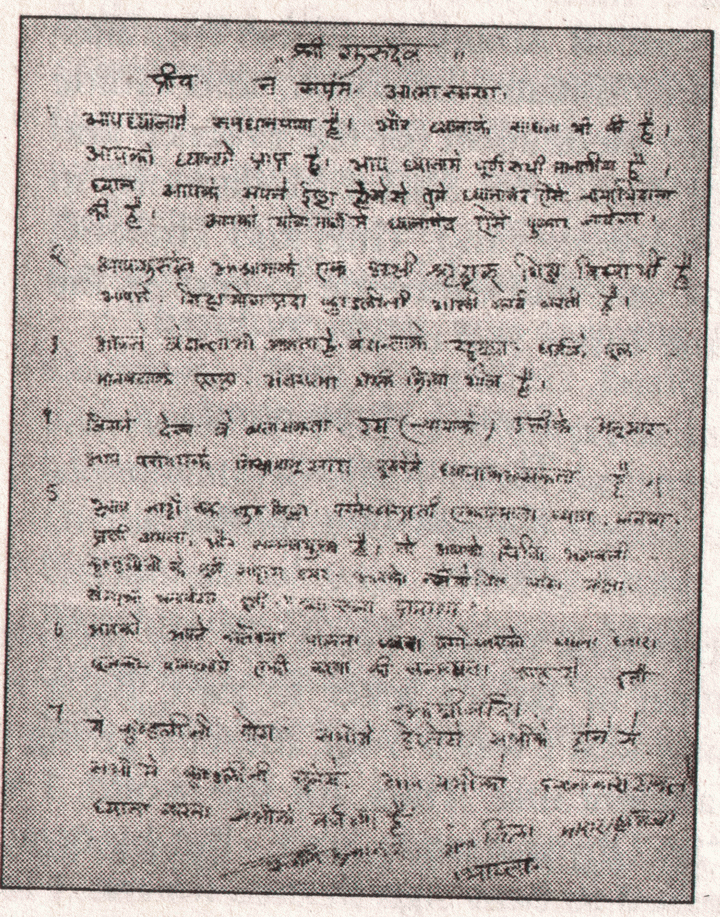
Muktananda’s handwritten letter to Franklin Jones,
1968
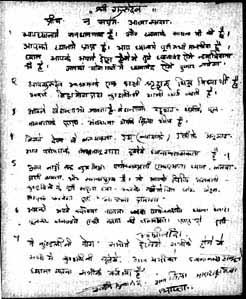
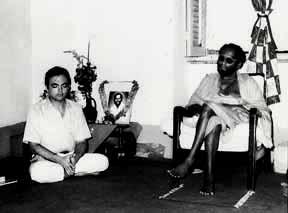
[ August,
1969, Bombay, India ]
Swami Muktananda’s letter of
acknowledgement
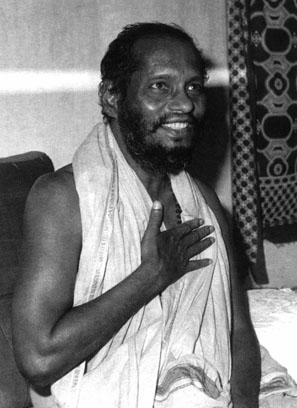
In August, 1969, Swami Muktananda
formally and publically acknowleged Adi Da’s Spiritual
Accomplishment in a open letter (pictured above left)
written in his own hand in the presense of Sri Adi Da and
between fifty and one-hundred others.
The Marathi language was Swami
Muktananda’s native tongue, and the letter, written in Hindi
interspersed with Sanskrit, presented many problems for
interpreters and translators. This page presents the four
most important versions, in their relative historical order,
with commentaries.
The first
initial rough translation was
prepared by a group of Swami Muktananda’s aides, and due to
the difficulty, took over two weeks before it was given to
Sri Adi Da. As later translations would show, it contains
added and missing elements, and does not, for whatever
reasons, convey the full content and intent of Swami
Muktananda’s message. 1
In the late 1970s several scholarly
translations were commisioned and although in some respects
they were better than the 1969 translation, they were
limited by their academic approach. In 1984, an Indologist
and scholar of various Adepts, with sensitivities to
spiritual terms, meanings and issues, brought forth another
translation; [ A.
J. Alston translation ] which
was published in the essay “The
Order of Free Names” in The
Illusion of Relatedness (1986); with Sri Love-Ananda’s
translation and commentary.
In 1989, a definitive word
for word transliteration was
obtained from a former translator for Swami Muktananda who
had lived with the Swami for many years and not only read
his handwriting with ease, but was also familiar with his
use of words and manners of expression.
In 1995, The
Order of My Free Names was
published with an updated rendering of the letter and
further exposition by Sri Adi Da: [
letter
] [ essay
excerpt ]
note to the reader
1. For a more in-depth history and
commentary see Appendix
A: The Translation of Swami Muktananda’s
Letter from The
Order of My Free Names (1995)
]